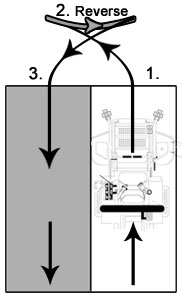|
|
 
|
|
Author
|
Topic: Anyone Here Own a Zero Turn Mower?
|
|
|
|
|
|
|
|
|
|
|
|
|
|
|
|
|
|
|
|
|
Joshua Waaland
Jedi Master Film Handler

Posts: 800
From: Cleveland, Ohio
Registered: Dec 1999
|
 posted 07-03-2009 09:01 AM
posted 07-03-2009 09:01 AM




Yes, that's what it means. Most zero turns are controlled by two levers like in the picture above. Each lever controls the flow of hydraulic fluid going to independent hydraulic motors on each rear wheel. If you push the left lever forward and pull the right lever back, the left wheel moves forward while the right wheel moves in reverse. This will make you spin in place in a clockwise circle. If you push both levers forward equally then you move forward in a straight line. If you move both levers forward and the right lever is pushed further than the left, then you will move forward but curve to the left because the right rear wheel is moving faster than the left rear wheel.
It's a very simple but great idea. The only thing you have to be careful of is actually trying to "turn on a dime". If you come to the end of a row and you stop the left wheel completely and drive the right wheel forward so that it does spin with a zero turn radius, then you will turf your lawn. The grip of the non moving rubber tire (in this case the left) on the grass while it is spinning but stationary will tear out the grass and leave a bare spot.
Scag recommends turning like this:
quote:
How can I turn with my zero turn riding mower without tearing the turf?
Although zero-turn mowers can turn on a dime (or in very tight circles), it is not the best practice to do so on the grass. Even tight turns have the potential to cause turf damage. The best way we have found to prevent and/or greatly minimize turf damage is to:

ĽUse 3-point / Y-turns at the end of a mowing row rather than zero-turns to change direction. It is still a fast maneuver and will reduce the potential of turf damage greatly.
1. At end of mowing path, turn toward next mowing path.
2. Reverse while turning slightly in opposite direction to align mower with next mowing row.
3. Proceed into next mowing path.
ĽOn "tight" turns, pay special attention to the inside drive wheel. This wheel will naturally spin slower than the outside drive wheel. It is important to keep the inside wheel turning at all times. If the turn is made to cause the inside wheel to stop turning, this is when turf damage can occur.
We have found that by using both of these methods, turf damage is all but a thing of the past. Over a short period of time, it becomes second nature and overall productivity can be increased.
| IP: Logged
|
|
|
|
|
|
|
|
|
|
All times are Central (GMT -6:00)
|
|
Powered by Infopop Corporation
UBB.classicTM
6.3.1.2
The Film-Tech Forums are designed for various members related to the cinema industry to express their opinions, viewpoints and testimonials on various products, services and events based upon speculation, personal knowledge and factual information through use, therefore all views represented here allow no liability upon the publishers of this web site and the owners of said views assume no liability for any ill will resulting from these postings. The posts made here are for educational as well as entertainment purposes and as such anyone viewing this portion of the website must accept these views as statements of the author of that opinion
and agrees to release the authors from any and all liability.
|

 Home
Home
 Products
Products
 Store
Store
 Forum
Forum
 Warehouse
Warehouse
 Contact Us
Contact Us




 Printer-friendly view of this topic
Printer-friendly view of this topic





![[beer]](graemlins/beer.gif)





![[Cool]](cool.gif)
![[Wink]](wink.gif)
![[evil]](graemlins/evil.gif)





![[Razz]](tongue.gif)
![[Smile]](smile.gif)



